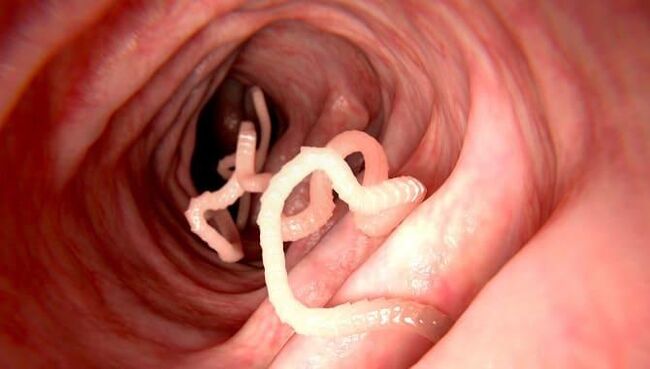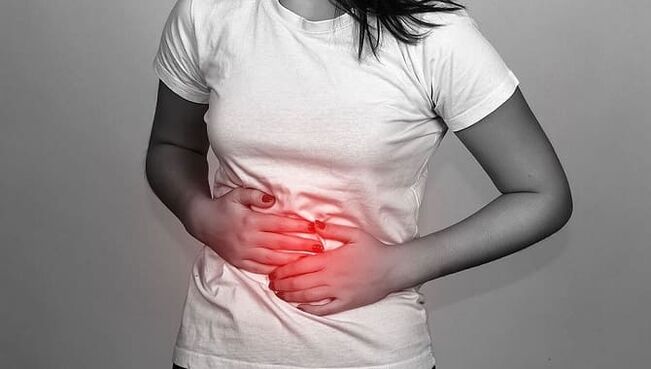what is worm

Classification of helminthiasis: Types of human helminths
- round (nematode)- Having an overall shape of lemon, linear, barrel or spindle. The head and tail of the nematode are slightly pointed. Oral appliances are characterized by three layers. Parasites move freely in soil, freshwater and seawater. Humans contain pinworms (which cause pinworm disease), roundworms, hookworms, and trichinella spiralis, which are all considered intestinal parasites. Guinea worm - These roundworms are spread through the subcutaneous tissue.
- Tape (tapeworm). This includes the following types of parasites: cattle, pork, dwarf tapeworm, broad tapeworm. Their body is like a thin ribbon, which can be 10 meters or more in length. The front part of the parasitic worm is equipped with suckers and hooks through which it attaches to the intestinal wall. Echinococcus tapeworms have a complex fixation system - 4 suckers surrounded by two rows of hooks.
- Flukes (trematodes)— This worm is characterized by a specific habitat in the body: gallbladder, bile duct. Representatives of flukes are Siberian flukes (4-13 mm) and Fasciolia (length 3-7 cm).

How did you get the parasite?
- Threadworms and flatworms Dwarf tapeworms enter the body through dirty hands, eating unwashed vegetables, and drinking dirty water. Habitat: Intestine.
- Trichinella spiralis, cattle, pork tapeworm - infection occurs when eating poorly heat-treated meat (beef, pork). Site: Intestine.
- Opisthorchis, a wide variety of tapeworms (class Flukes or Cestoda). People can become infected by eating raw, unsalted, or undercooked fish. In fish, parasite larvae live in fat layers and muscles. In humans, they colonize the liver and gallbladder.
- Echinococcus, Siberian flukes, and Fasciolia are transmitted through contact with infected dogs; cats are a less common source of infection. Worms can live in the human liver, lungs, kidneys and heart. They develop within echinococcal cysts.
What do worms in human feces look like?
Signs of worms in humans
during acute phase
in chronic phase
Intestinal helminthiasis
- worsening of digestion;
- Tenderness in the navel area;
- Intestinal dysfunction;
- Loss of appetite;
- lose weight;
- Pale skin;
- Bruising under the eyes;
- Anal itching.

extraintestinal helminthiasis
- persistent fatigue;
- neurasthenia;
- Paroxysmal pain in the upper abdomen;
- performance degradation;
- Foul-smelling, fatty stools (steatorrhea);
- Urticaria, itchy skin;
- chest pain;
- chronic dry cough;
- Changes in skin color.
How to Detect Worms: Diagnosis of Worm Infection
- blood analysis- Elevated eosinophil levels and decreased hemoglobin levels indicate helminth infection.
- duodenal probing- Examination of duodenal secretions helps identify opioditis, giardiasis, and other human extraintestinal helminths.
- Ultrasound examination of the abdomen and other parts of the body— Examine the gastrointestinal tract, liver, gallbladder, ducts, pancreas, muscles, brain, lungs for the presence of pathological changes characteristic of worm life (seals, cysts, nodules, blockages).
- Chest X-ray- This test is performed if pulmonary parasites are suspected (roundworms, echinococcosis, tapeworm larvae detected).
- CT scan- Detection of worms in the human brain, eyes and lungs.
- capsule endoscopy- Identify tape parasites.
- Enzyme-linked immunosorbent assay— Tests blood for antibodies against most known parasites.
How to get rid of worms quickly and effectively
Diet and Hygiene Features
- meat, lard;
- All types of sweets;
- fresh milk;
- baked goods;
- Wheat porridge, pasta;
- Coffee, alcohol.

drug
- Benzimidazole broad-spectrum anthelmintic - effective against nematodes and flukes. It is prohibited for children under 2 years old and should be used with caution by pregnant and lactating women. The dosage and frequency of taking the medication depends on the type of worm. For roundworms and mixed infections, prescribe 1 tablet. 2 times a day for three consecutive days. For treatment of pinworms, take 1 tablet daily for three consecutive days. Repeat the course after 21 days. Hydatid in adults can be eliminated by increasing the dose of the drug: the first 3 days - 500 mg in the morning and evening, the next 3 days - 500 mg 3 times a day, until complete recovery from the parasite. The duration of treatment for hydatid disease is determined by your doctor (4 to 6 weeks).
- Pyrazinoisoquinoline broad-spectrum anthelmintics. Contraindicated in children under 4 years of age and pregnant women (first month of pregnancy). Effective against muscle/tissue worms. Urogenital schistosomiasis (worms live in blood vessels near the bladder), intestines and abdomen are treated with a single dose of the drug (40 mg/10 kg). For severe parasitic vasculopathy, take tablets 20-25 mg/10 kg 3 times daily (every 6 hours).
- Broad-spectrum drugs of the benzimidazole class. Not for use on children under 2 years of age, pregnant or breastfeeding women. For the treatment of intestinal helminths, 400 mg/day for adults and 60 mg/10 kg for children. For parasites in the brain, the prescription is 800 mg/day for adults and 15 mg/kg for children, with a course of 8-30 days.
Antihelmintic drugs are toxic. They are not suitable for people with liver failure, ulcerative colitis, or Crohn's disease.
traditional method
- Grind flax seeds (1 tablespoon). Pour the powder into 0. 5 liters of cold water. Bring the mixture to a boil, cover and simmer for 20 minutes. Drink 100 ml on an empty stomach in the morning and evening for 10 consecutive days. This formula helps fight nearly all parasites that can live in the human body - pinworms, tapeworms, giardia.
- Grind 300g of dried but not fried pumpkin seeds. Add enough warm boiled water to the powder to make a paste. Add a tablespoon of honey. Eat the entire mixture on an empty stomach. After 4 hours, take a laxative. This formula is effective against human intestinal worms.

Which parasites can only be removed surgically?
- Intestinal obstruction - a pathological condition caused by roundworms, tapeworms, flukes and other worms.
- Intestinal wall perforation - The bovine tapeworm burrows a hole in the intestinal wall and then enters the human abdominal cavity.
- Parasitic cholecystitis and subsequent pancreatic necrosis is caused by band-shaped parasites blocking the bile ducts.
How dangerous are parasitic infections to the body?
How to protect yourself from infection
- Follow personal hygiene rules carefully.
- Treat parasites in your pet promptly.
- Heat-process the fish for 60 minutes and the meat for 2-3 hours.

























